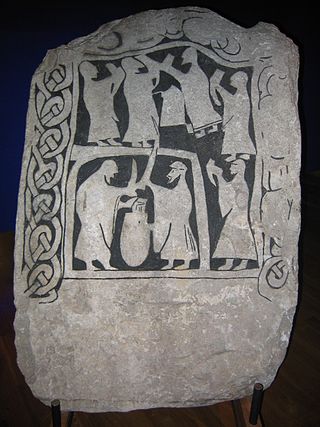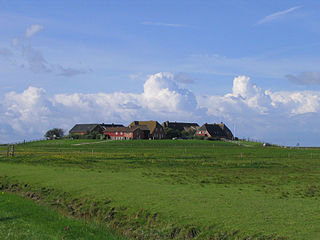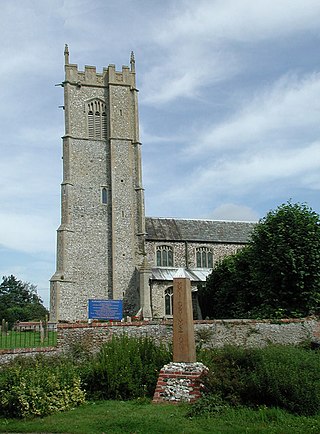The topic of this article may not meet Wikipedia's general notability guideline .(March 2020) |
Thorp is a Middle English word for a hamlet or small village.
The topic of this article may not meet Wikipedia's general notability guideline .(March 2020) |
Thorp is a Middle English word for a hamlet or small village.
The name can either come from Old Norse þorp (also thorp), [1] or from Old English (Anglo-Saxon) þrop. [2] There are many place names in England with the suffix "-thorp" or "-thorpe". Those of Old Norse origin are to be found in Northumberland, County Durham, Yorkshire, Lincolnshire, Cambridgeshire, Norfolk, and Suffolk. Those of Anglo-Saxon origin are to be found in southern England from Worcestershire to Surrey. Care must be taken to distinguish the two forms. Variations of the Anglo-Saxon suffix are "-throp", "-thrope", "-trop" and "-trip" (e.g. Adlestrop and Southrope). [2]
Old English (Anglo-Saxon) þrop is cognate with Low-Saxon trup/trop/drup/drop as in Handrup or Waltrop, Frisian terp , German torp or dorf as in Düsseldorf, the 'Village of the river Düssel', and Dutch dorp. [3]
It also appears in Lorraine place-names as -troff such as Grosbliederstroff (France) in front of Kleinblittersdorf (Germany). It sometimes occurs in Normandy as Torp(s) / Tourp(s) / -tourp or even -tour, for instance : le Torp-Mesnil, le Tourp, Clitourps or Saussetour (Manche, Sauxetorp end 12th century, like Saustrup, Schleswig-Holstein, Germany, former Saxtorppe and Saxtorf, former Saxtorpe 1538 idem, and Saxthorpe in Norfolk, England), all from Old Norse [4] or Old English.
"Thorp" as a word appears in some role-playing games, where it is used to denote the smallest form of permanent collective habitation in the game world. Thorps in Dungeons and Dragons are defined as having between 20–80 inhabitants, while Pathfinder defines them as having 20 or fewer. [5] Hamlets are the next most populous, housing 81–400 or 21–60 people in the respective games.
The toponymy of England derives from a variety of linguistic origins. Many English toponyms have been corrupted and broken down over the years, due to language changes which have caused the original meanings to be lost. In some cases, words used in these place-names are derived from languages that are extinct, and of which there are no known definitions. Place-names may also be compounds composed of elements derived from two or more languages from different periods. The majority of the toponyms predate the radical changes in the English language triggered by the Norman Conquest, and some Celtic names even predate the arrival of the Anglo-Saxons in the first millennium AD.

Symbel (OE) and sumbl (ON) are Germanic terms for "feast, banquet".
Oisc, or, in a later spelling, Ēsc was, if he existed, an early king of Kent and, according to Bede, the eponymous founder of the tribe known as Oiscingas (early Old English.

Burnham Thorpe is a village and civil parish in the English county of Norfolk. It is famous for being the birthplace of Vice Admiral Horatio Nelson, victor at the Battle of Trafalgar and one of Britain's greatest heroes. At the time of his birth, Nelson's father, Edmund Nelson, was rector of the church in Burnham Thorpe.
Placenames in the German language area can be classified by the language from which they originate, and by era.
In much of the "Old World" the names of many places cannot easily be interpreted or understood; they do not convey any apparent meaning in the modern language of the area. This is due to a general set of processes through which place names evolve over time, until their obvious meaning is lost. In contrast, in the "New World", many place names' origins are known.
Thorpe is a variant of the Middle English word thorp, meaning hamlet or small village.

Fryup is a hamlet in the North York Moors National Park in North Yorkshire, England. It is within the civil parish of Danby, and is located alongside Great Fryup Beck in Great Fryup Dale.

A terp, also known as a wierde, woerd, warf, warft, werf, werve, wurt or værft, is an artificial dwelling mound found on the North European Plain that has been created to provide safe ground during storm surges, high tides and sea or river flooding. The various terms used reflect the regional dialects of the North European region.

Burythorpe is a village and civil parish in North Yorkshire, England, about 4 miles (6 km) south of Malton. According to the 2001 census it had a population of 289, reducing marginally to 286 at the Census 2011. The Whitegrounds barrow is nearby.
Germanic toponyms are the names given to places by Germanic peoples and tribes. Besides areas with current speakers of Germanic languages, many regions with previous Germanic speakers or Germanic influence had or still have Germanic toponymic elements, such as places in France, Wallonia, Poland, Northern Portugal, Spain and Northern Italy.
A "-wich town" is a settlement in Anglo-Saxon England characterised by extensive artisanal activity and trade – an "emporium". The name is derived from the Anglo-Saxon suffix -wīc, signifying "a dwelling or fortified place".
A thorp is a hamlet or village.

Grimston is a village and civil parish in the English county of Norfolk, approximately 6 miles north-east of King's Lynn. It covers an area of 18.08 km2 (6.98 sq mi) and had a population of 1,952 in 823 households at the 2001 census, increasing to a population of 1,980 at the 2011 census. For the purposes of local government, it falls within the district of King's Lynn and West Norfolk.

Thorp Perrow Arboretum is an 85-acre (34 ha) woodland garden arboretum near Bedale in North Yorkshire, England.

-hou or hou is a place-name element found commonly in the Norman toponymy of the Channel Islands and continental Normandy.
Germanic given names are traditionally dithematic; that is, they are formed from two elements, by joining a prefix and a suffix. For example, King Æþelred's name was derived from æþele, meaning "noble", and ræd, meaning "counsel".

Placenames in Normandy have a variety of origins. Some belong to the common heritage of the Langue d'oïl extension zone in northern France and Belgium; this is called "Pre-Normanic". Others contain Old Norse and Old English male names and toponymic appellatives. These intermingle with Romance male names and place-name elements to create a very specific superstratum, typical of Normandy within the extension zone of the Langue d'oïl. These are sometimes called "Normanic".
Thwaite is a common element of placenames in North West England, and Yorkshire. It is also found elsewhere in England, including two places called Thwaite in Norfolk and one in Suffolk. It is most often found as a suffix. It is a common element of field names, as well as settlement names. It is most frequent in the North West, where some 80 examples are found in Cumberland, at least 30 in Westmorland, about 40 in Lancashire and 30 in the North Riding, whilst it is common in the western parts of the West Riding. Elsewhere in England it is rare, only three examples occurring in the East Riding and seven in Nottinghamshire.
Tritton is an English surname of Anglo-Norman origin.